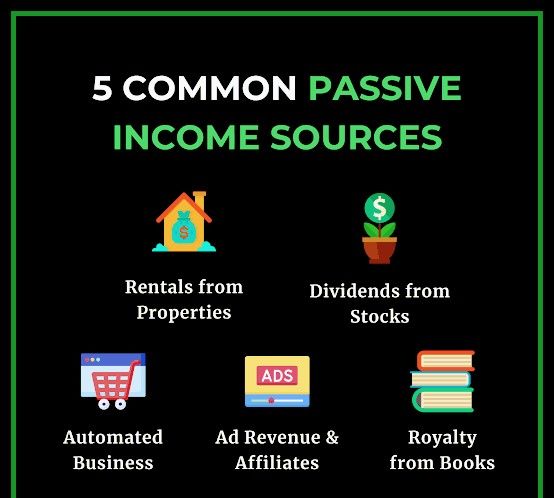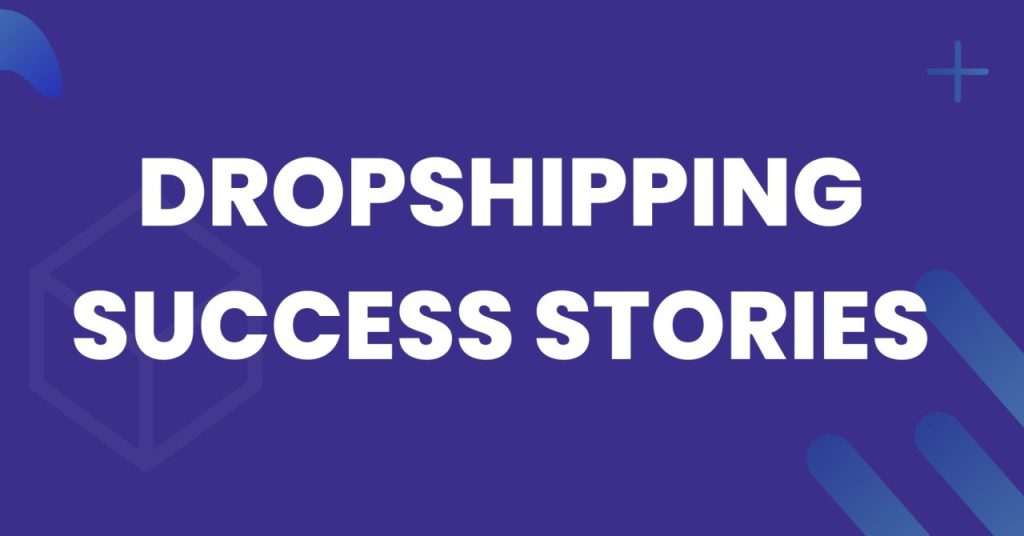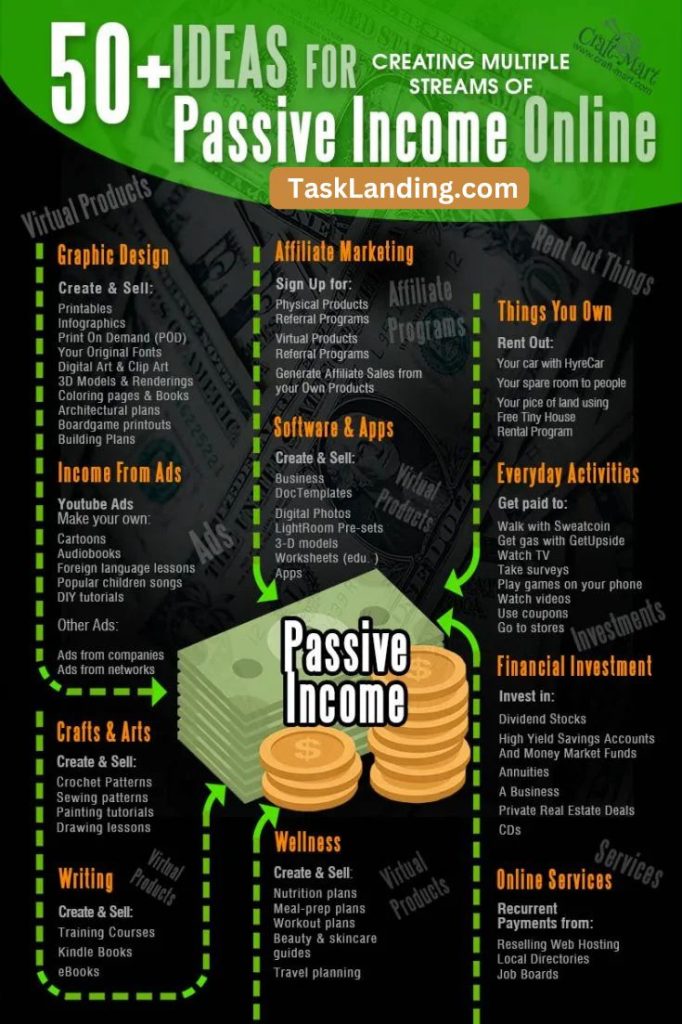In today’s fast-paced digital economy, passive income, precisely dropshipping passive income has become an attractive option for people looking to make money without being tied to a traditional 9-to-5 job.
Among various passive income strategies, dropshipping stands out as a potentially lucrative and relatively simple business model that, when executed correctly, can provide a steady stream of income with minimal ongoing effort.
Dropshipping allows you to sell products online without handling inventory, shipping, or fulfillment.
By automating key processes, dropshipping can become a source of passive income that generates consistent money over time.
In this comprehensive guide, we’ll explore how dropshipping can help you achieve passive income, how much you can realistically expect to earn, and valuable lessons from successful dropshippers.
Additionally, I’ll share 50 passive income ideas beyond dropshipping and answer some of the most common questions about generating passive income with dropshipping.
To start with, it is imperative to know what we are talking about.
Read other passive income blogs
- The Best Side Hustle for Nurses
- 16 Passive Income Ideas
- 23 Side Hustle Jobs
- 25 Hobbies That Make Money
What Is Passive Income?
Passive income is money earned with little to no active involvement after the initial setup.
Unlike traditional income, where you exchange time for money (e.g., a salaried job or hourly work), passive income continues to flow even when you are not actively working.
The goal is to build a system or asset that generates income automatically over time.
Common Forms of Passive Income

Passive income comes in many forms, and each type requires a different level of effort, risk, and return potential.
Here are some of the most common and reliable forms of passive income, providing a comprehensive overview of opportunities to build wealth over time.
1. Rental Income
How it works: As a property owner, you lease the property to tenants and receive monthly rent payments. The income is considered passive because, once the property is rented, you do not have to put in daily effort to maintain it, especially if you hire a property manager.
Benefits: Rental properties can appreciate in value over time, providing both regular income and long-term investment growth. Tax advantages, such as deductions for property depreciation and maintenance expenses, make real estate investing even more attractive.
Challenges: Initial costs can be high, as purchasing real estate often requires significant upfront capital. Additionally, dealing with problematic tenants or unexpected maintenance issues may require active management.
2. Dividend-Paying Stocks
How it works: Dividends are payments made to shareholders based on a company’s earnings. By holding shares in these companies, you become eligible to receive a portion of the profits in the form of dividend payments, which are usually distributed every quarter.
Benefits: Dividend stocks offer a relatively passive way to earn income while also benefiting from the appreciation of the stock’s value. Many investors use dividend reinvestment programs (DRIPs) to automatically reinvest their dividends into more shares, compounding their returns over time.
Challenges: Stock prices can be volatile, and dividend payments are not guaranteed. Companies may cut or eliminate dividends during economic downturns or when their financial performance is weak. Additionally, significant capital may be required to generate meaningful income from dividends.
3. Peer-to-Peer Lending
How it works: P2P lending platforms connect investors (lenders) with borrowers. You can choose how much money you want to lend and to whom, and borrowers repay the loan over a fixed period with interest. The interest payments provide you with passive income.
Benefits: The potential returns can be higher than traditional savings accounts or bonds, depending on the creditworthiness of the borrower. You also have the flexibility to choose loans with different risk levels.
Challenges: There is always the risk of borrowers defaulting on their loans, which can lead to a loss of your investment. Some platforms may mitigate this risk by allowing you to invest small amounts in multiple loans, diversifying your portfolio. However, P2P lending is still considered a higher-risk form of passive income.
When explaining the main challenges, Moneyhelper.org.uk said that many people find themselves defaulting, paying early or late, and the fear of the P2P site going bust.
4. Real Estate Investment Trusts (REITs)
How it works: When you invest in a REIT, you buy shares of the company that manages real estate assets, such as office buildings, shopping centers, or residential apartments. REITs are required by law to distribute at least 90% of their taxable income to shareholders, making them a reliable source of passive income.
Benefits: REITs provide exposure to the real estate market without the challenges of property ownership and management. They offer a steady stream of income through dividends and can be bought and sold like stocks, providing liquidity that traditional real estate investments lack.
Challenges: While REITs can provide a relatively high dividend yield, their value can fluctuate with the real estate market and economic conditions. Additionally, REIT dividends are taxed as regular income, which may result in a higher tax burden compared to qualified dividends from stocks.
5. Digital Products
How it works: You create a digital product once and sell it through online platforms like Gumroad, Udemy, or your website. Customers can purchase and download the product instantly, and you earn income without having to fulfill physical orders.
Benefits: After the initial creation of the product, sales can continue indefinitely with little additional effort. Digital products also have high profit margins since there are no inventory or shipping costs.
Challenges: Creating a high-quality digital product requires upfront time and effort. Additionally, marketing is essential to driving traffic to your product page, and competition in the digital product market can be intense.
6. YouTube Ad Revenue
How it works: You create and upload videos to YouTube, and once you meet the platform’s eligibility requirements (1,000 subscribers and 4,000 watch hours), you can join the YouTube Partner Program. YouTube places ads on your videos, and you earn revenue based on the number of views and ad clicks.
Benefits: Once your videos are published and gain views, you can continue earning ad revenue long after the content was created. Additionally, YouTube videos can provide a long-term source of income as popular videos can generate views for years.
Challenges: Growing a YouTube channel to the point where it generates meaningful income requires consistent content creation and audience engagement. Competition on the platform is high, and it can take time to build a loyal subscriber base.
7. Investing in Bonds
How it works: You invest in bonds, and the issuer pays you regular interest (called a coupon payment) until the bond matures. At maturity, you receive the face value of the bond.
Benefits: Bonds are generally considered a low-risk investment, especially government bonds, and they provide a stable and predictable source of income. They are ideal for risk-averse investors who want to generate passive income with minimal volatility.
Challenges: While bonds are safer than stocks, their returns are generally lower. Inflation can erode the purchasing power of bond interest payments, and corporate bonds carry a higher risk of default compared to government bonds.
How Much Dropshipping Passive Income Can You Generate Per Month?
The amount of passive income you can generate through dropshipping varies significantly based on several factors, including:
Product Selection: The profitability of your products depends on their demand, competition, and pricing. Niche products with less competition tend to offer higher profit margins.
Marketing Strategy: A well-executed marketing strategy can dramatically boost sales. Effective use of social media ads, SEO, and email marketing can attract more customers to your store.
Automation: Automating tasks such as order fulfillment, customer communication, and inventory management can help you scale your business without significantly increasing your workload.
Supplier Relationships: Reliable suppliers ensure that orders are fulfilled promptly and accurately, which is crucial for maintaining customer satisfaction and minimizing refunds or returns.
Customer Service: While dropshipping is often considered a passive income model, providing great customer service is essential to building trust and encouraging repeat business. Automating aspects of customer service (e.g., with chatbots) can help manage customer interactions without constant involvement.
On average, a small dropshipping store can earn between $200 to $2,000 per month, depending on the level of effort and optimization.
More experienced entrepreneurs who invest in multiple stores, advanced marketing strategies, and scaling their operations may earn $5,000 to $50,000 or more per month.
Here’s a rough breakdown of potential earnings at different levels:
- Beginner: $200 to $1,000 per month — A beginner-level dropshipper may generate moderate sales by targeting a niche market and promoting products through basic marketing tactics.
- Intermediate: $1,000 to $5,000 per month — At this level, store owners have refined their marketing strategies, increased traffic to their site, and optimized their product selection, leading to higher sales and profit margins.
- Advanced: $5,000 to $50,000+ per month — With advanced dropshipping techniques like paid advertising, influencer marketing, and multiple revenue streams (e.g., upsells and cross-sells), dropshippers can scale their business to significant earnings.
What You Can Learn from Successful Dropshippers

To succeed in dropshipping, it’s important to learn from those who have already achieved significant results.
Here are some key takeaways from successful dropshippers that can help you maximize your passive income potential:
a. Niche Down
One of the most common traits among successful dropshippers is their focus on a specific niche.
Rather than trying to sell everything to everyone, they select a niche market with a targeted audience.
This allows them to create specialized marketing campaigns and build a brand that resonates with a specific group of customers.
Why it works: Niching down helps you stand out from the competition and create a loyal customer base that trusts your expertise. For example, instead of selling generic home decor, focus on eco-friendly, sustainable decor products to attract environmentally conscious consumers.
b. Test Products Regularly
Successful dropshippers understand that not all products will sell well. They continuously test new products to find top sellers and remove underperforming items from their store.
Why it works: Constant testing allows you to discover new trends and capitalize on products that generate higher profits.
Dropshippers often test products through paid ads and use analytics tools to track which items perform the best.
c. Invest in Marketing
Marketing is one of the most important aspects of running a successful dropshipping business.
While organic traffic through SEO is valuable, most successful dropshippers rely heavily on paid advertising, particularly Facebook Ads, Instagram Ads, and Google Ads, to drive traffic to their stores.
Why it works: Paid ads can help you reach a broader audience, scale your business faster, and generate consistent sales. By investing in targeted ad campaigns, you can attract high-quality traffic and boost conversion rates.
d. Focus on Customer Experience
While dropshipping is a low-effort business model, providing an exceptional customer experience is crucial for success.
This includes clear communication, fast shipping, and quality products.
Successful dropshippers often go the extra mile to ensure their customers are happy, which leads to positive reviews, repeat purchases, and word-of-mouth referrals.
Why it works: Happy customers are more likely to return and recommend your store to others. Offering excellent customer service, even in a dropshipping model, can significantly impact long-term profitability.
e. Automate Key Processes
To make dropshipping as passive as possible, successful entrepreneurs use automation tools to handle tasks like inventory management, order processing, and customer communication.
Platforms like Shopify and WooCommerce offer integrations with various tools that can streamline your workflow and save time.
Why it works: Automation reduces the amount of manual labor required to run a dropshipping store, allowing you to focus on growing your business rather than getting bogged down in day-to-day tasks.
50 Passive Income Ideas

While dropshipping is a great way to generate passive income, it’s not the only option.
To diversify your income streams and maximize your financial stability, consider these 50 passive income ideas across various industries:
- Airbnb hosting
- Rental properties (real estate)
- Dividend-paying stocks
- Peer-to-peer lending
- Affiliate marketing
- Create and sell an online course
- Start a YouTube channel (monetized via ads)
- Sell digital products (e-books, templates, printables)
- Print-on-demand business
- Licensing music or artwork
- Invest in REITs (real estate investment trusts)
- Invest in index funds
- Create and sell an app
- Sell stock photography
- Write and sell e-books
- Create a membership site or subscription service
- Sell handmade crafts on Etsy
- Sell software as a service (SaaS)
- Car rental (Turo, Getaround)
- Create a blog and monetize it with ads
- License intellectual property (patents, trademarks)
- Sell data analysis reports
- Offer website hosting services
- Dropshipping business
- Create and sell workout programs
- Start a podcast and monetize it
- License designs for product manufacturing
- Invest in high-yield savings accounts
- Start a vending machine business
- Real estate crowdfunding
- Build a mobile game app
- Buy and flip domain names
- Invest in cryptocurrency staking
- Run a paid newsletter
- Peer-to-peer car sharing
- Invest in bonds
- Crowdfund renewable energy projects
- Sell virtual real estate in the metaverse
- Invest in fine art or collectibles
- Rent out office or warehouse space
- Rent out equipment (tools, cameras, etc.)
- Set up a laundromat
- Buy and manage a parking lot
- Create niche websites and sell ad space
- Lease land for cell towers or billboards
- Buy an existing online business
- Automated cryptocurrency trading bots
- Sell 3D-printed products
- Invest in fractional ownership real estate
- Invest in farmland
Dropshipping Passive Income FAQs
Q. Can Dropshipping Be Passive?
A: Yes, dropshipping can be a form of passive income once the business is set up and automated. The key to making dropshipping passive lies in automating key tasks such as inventory management, order fulfillment, and customer service. By using tools and software to streamline these processes, you can reduce the time spent managing your store, turning it into a more hands-off income stream. However, achieving true passivity requires regular optimization and maintenance, especially in the beginning stages.
Q: How Can I Make $1,000 a Month in Passive Income with Dropshipping?
A: To make $1,000 a month in passive income from dropshipping, follow these steps:
- Find a profitable niche: Focus on products with high demand and low competition. Look for trending items or evergreen products that sell consistently.
- Build a user-friendly store: Use platforms like Shopify to create a professional-looking store. Ensure that it is optimized for mobile users and easy to navigate.
- Automate processes: Use apps and tools like Oberlo or AliExpress to automate order fulfillment and inventory management.
- Invest in marketing: Spend time learning paid advertising strategies such as Facebook Ads and Google Ads. A solid marketing strategy can quickly boost sales and help you reach your $1,000 monthly goal.
- Monitor and adjust: Regularly analyze your store’s performance. Adjust your product selection, pricing, and marketing tactics based on what works best.
Q: Can You Really Make Money with Dropshipping?
A: Yes, you can make money with dropshipping. Many entrepreneurs have turned dropshipping into a full-time income stream, earning anywhere from a few hundred dollars to tens of thousands per month. However, like any business, it requires effort, persistence, and strategy to succeed. The most successful dropshippers invest time in product research, marketing, and automation. While it’s possible to generate passive income, it may take some time to reach that point, and you may need to experiment with different approaches before finding success.
Summary
Dropshipping offers a scalable, flexible, and relatively low-risk way to generate passive income. By focusing on the right niche, automating your processes, and refining your marketing strategy, you can turn your online store into a hands-off source of income.
While it may take time and effort to reach a stage where the income is truly passive, the potential rewards are significant.
Moreover, dropshipping is just one of many passive income opportunities available. From rental properties and dividend-paying stocks to creating digital products and starting a YouTube channel, there are countless ways to diversify your income streams and build long-term wealth.
With careful planning and a focus on automation, dropshipping can provide a consistent stream of passive income. If you’re looking for a flexible way to make money online, dropshipping is a business model worth exploring.











